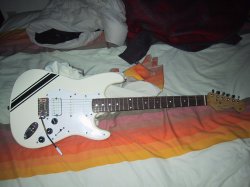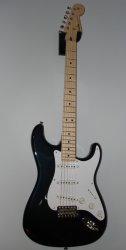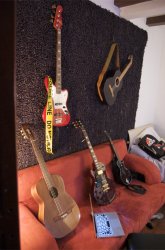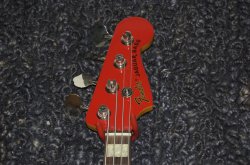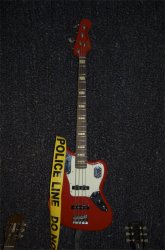Got a tip for us?
Let us know
Become a MacRumors Supporter for $50/year with no ads, ability to filter front page stories, and private forums.
Post Your Guitar
- Thread starter nickster9224
- Start date
- Sort by reaction score
You are using an out of date browser. It may not display this or other websites correctly.
You should upgrade or use an alternative browser.
You should upgrade or use an alternative browser.
Hey guys, I'm looking into getting a Guitar for just casual playing, not in a band or anything (My first guitar-Electric). I don't want to spend over 150$ for everything- Thats an Amp and a guitar right? anything else I need?.
Anyways, what do you suggest?
I would look at Fender's beginners Squier models. They cost around $250-300 and include amp, case, jack, strap and plectrums.
ams.
EDIT: Oh and I got a Marshall MG50DFX Amp for xmas!
150 for everything? oh man. is this even possible? id suggest craigslist as your best bet
Yeah. I'm looking at Mr. Craptastic guitar here.
Getting my first Guitar next week for my Bday! I'm getting an Epiphone Les Paul Studio ( Alpine White ) !can't wait! I'll post some pics next week when I get it.
Excellent choice! I passed up a good deal on an Alpine White LP and I still regret it.
Yeah. I'm looking at Mr. Craptastic guitar here.
Try and stretch to a Yamaha Pacifica 112. They're proper guitars, well made and fun to play. A lot better quality than the cheaper Squirers - and less likely to put you off.
First is my Todd Krause Clapton strat.
Second is my Gibson SG '61 which I have since sold, what a mistake. Great guitar...even if it did go out of tune allllll the time.
Then I have a Martin 000-28EC, which is about 10 years old already.
Second is my Gibson SG '61 which I have since sold, what a mistake. Great guitar...even if it did go out of tune allllll the time.
Then I have a Martin 000-28EC, which is about 10 years old already.
Attachments
First is my Gibson SG '61 which I have since sold, what a mistake. Great guitar...even if it did go out of tune allllll the time.
Second is my Martin 000-28EC - love it. It's about...10 years old now.
Man that sure is a fender-y looking sg
Excellent choice! I passed up a good deal on an Alpine White LP and I still regret it.
Thanx! I ordered it from Musicians Friend for $299, they also had 3 years of repair and accidental damage, otherwise I would have gotten it at my local guitar center ( they only have a 2 year with no accidental ).
HOW MUCH was the offer you passed on?
My two main guitars, a 1958 reissue Les Paul and a 1957 (goldtop) reissue. (both of which have recieved many modifications like electronic changes, hardware and plastic changes (to correct materials and color) and I even changed the inlays in both guitars, to use period correct cellulose nitrate, imported from the original Italian manufacturer that was used in the late 50's by Gibson. You can see in both pics on the right how white the inlays were right after installing them, and how they now have taken on an aged patina through UV and die treatments.












My two main guitars, a 1958 reissue Les Paul and a 1957 (goldtop) reissue. (both of which have recieved many modifications like electronic changes, hardware and plastic changes (to correct materials and color) and I even changed the inlays in both guitars, to use period correct cellulose nitrate, imported from the original Italian manufacturer that was used in the late 50's by Gibson. You can see in both pics on the right how white the inlays were right after installing them, and how they now have taken on an aged patina through UV and die treatments.
Sooooo beautiful !!!! I'm getting an epiphone studio soon as I stated earlier ( I'm a beginner ) but I would love to own one like this later on!! VERY NICE!!

Thanks, they are my babies.
Just as long as the guitar makes you want to play it, then its a good guitar. The only thing I recommend you do is take your guitar, when you get it, to a reputable guitar tech and spend $60 to $70 bucks and have it set up properly.
I worked as a guitar-tech for several years and was amazed at how people would judge guitars based on how they played alone. A good set-up low-end guitar will rival any poorly set up high-end guitar. Playability first, tone second. (thats when it gets expensive)
Practice practice!
Thanks, they are my babies.
The only thing I recommend you do is take your guitar, when you get it, to a reputable guitar tech and spend $60 to $70 bucks and have it set up properly.
... A good set-up low-end guitar will rival any poorly set up high-end guitar.
I second this. No matter how many times a manufacturer says "they play perfect off the rack" it is not true. For example Ibanez usually ships their locking tremolo models with many shims under the headstock nut. They are not all needed and are mostly there for storage. Find a well respected tech and let them work their magic.
Thanks, they are my babies.
Just as long as the guitar makes you want to play it, then its a good guitar. The only thing I recommend you do is take your guitar, when you get it, to a reputable guitar tech and spend $60 to $70 bucks and have it set up properly.
I worked as a guitar-tech for several years and was amazed at how people would judge guitars based on how they played alone. A good set-up low-end guitar will rival any poorly set up high-end guitar. Playability first, tone second. (thats when it gets expensive)
Practice practice!
Thanks for the info
Thanks for the infowhere would I find a reputibale tech? Is there a way I could pm you when I get it and walks through it? You sound very knowledgable

Call around to your local music shops, and get opinions.
In terms of PM'ing me for advice, just find this thread again and click on my user name and send me a PM, I'm more then happy to lend some advice, no matter what the question may be.
Call around to your local music shops, and get opinions.
In terms of PM'ing me for advice, just find this thread again and click on my user name and send me a PM, I'm more then happy to lend some advice, no matter what the question may be.
Thanx alot
My two main guitars, a 1958 reissue Les Paul and a 1957 (goldtop) reissue. (both of which have recieved many modifications like electronic changes, hardware and plastic changes (to correct materials and color) and I even changed the inlays in both guitars, to use period correct cellulose nitrate, imported from the original Italian manufacturer that was used in the late 50's by Gibson. You can see in both pics on the right how white the inlays were right after installing them, and how they now have taken on an aged patina through UV and die treatments.






Those are so nice. Glad to see a fellow collector knowing their facts. I loved vintage Fenders but for legal reasons, I am a law student, Fender messed with the spacing of the double dots on the 12th fret, so there is no way to make any US reissues accurate to early-Leo Fenders.
However, for a short time, Fender Japan had the specs correct for vintage Fenders, but that too has since passed. One thing Fender Japan and Fender USA had wrong when they did get stuff right was that they put the Fender decal "under" the finish. When Fender did get the decal over the finish as was proper before 1968, they changed a lot of other factors within the guitar to stop fraud.
Gibson, also being smart legally, made the binding ever so slightly the wrong dimensions to keep collectors safe from frauds. One person I bought from had a Les Paul with the correct 1950s serial number, but I know Gibson unfortunately recycled some serial numbers. What gave away the real date of the Les Paul, from the '70s as a reissue, besides the date on the volume and tone pots, was the slightly thicker dimensions of the body binding.
When I showed the seller this information from several sources, he was truly bummed, but I set him straight. In many cases the best wiring, pickup winding, and overall workmanship, for Gibson, was best done on some reissues as they were able to play at medium to high volumes w/o serious feedback issues. The older models may have not had the correct wax dipping of coils to avoid this problem. While real vintage Gibsons sounded great clean at low volumes, they became microphonic at medium and high volumes and downright nasty, in a bad way, through a 50-100 watt Marshall at the louder volumes.
Sometimes the ultra thick, unplayable old Gibson necks are paired, more often than not, with the best tigerstripe maple tops found on early Les Paul Standards.
From left to right (in the first picture):
1. 30-year-old handmade Colombian acoustic guitar. Made by luthier Carlos R. Norato.
2. Fender Jaguar 4-string Bass Guitar (my current and beloved bass)
3. Gibson Les Paul Studio left-handed. It's actually not mine, it belongs to one of my guitarists and the other guitarist has the EXACT same model just that its for right-handed people; pretty funny .
.
4. 11-year-old Costa Rican handmade acoustic guitar, made by a famous costarican guitar maker (is not that good actually).
5. Gibson Les Paul guitar hero controller yah, I had to include it in teh pic.
yah, I had to include it in teh pic.
Missing: my old Squier P-Bass and a busted mexican guitar my grandpa bought on a trip there.
Victor
1. 30-year-old handmade Colombian acoustic guitar. Made by luthier Carlos R. Norato.
2. Fender Jaguar 4-string Bass Guitar (my current and beloved bass)
3. Gibson Les Paul Studio left-handed. It's actually not mine, it belongs to one of my guitarists and the other guitarist has the EXACT same model just that its for right-handed people; pretty funny
4. 11-year-old Costa Rican handmade acoustic guitar, made by a famous costarican guitar maker (is not that good actually).
5. Gibson Les Paul guitar hero controller
Missing: my old Squier P-Bass and a busted mexican guitar my grandpa bought on a trip there.
Victor
Attachments
hey guys I also wanted to buy an acoustic guitar is this one good? I found it off craigslist in my city, He says it's a yamaha in good condition with 2 strings that need replacing. He wants $25 but I can't tell which model it is or how much it's worth any help would be appreciated here is the link. ( I know it's not a pic of MY guitar as the forum states but it could be ) 
YAMAHA ACOUSTIC
YAMAHA ACOUSTIC
hey guys I also wanted to buy an acoustic guitar is this one good? I found it off craigslist in my city, He says it's a yamaha in good condition with 2 strings that need replacing. He wants $25 but I can't tell which model it is or how much it's worth any help would be appreciated here is the link. ( I know it's not a pic of MY guitar as the forum states but it could be )
YAMAHA ACOUSTIC
It's not some unknown name and most Yamahas I have seen are pretty solid and a good value for the money. Unless this guitar is severely warped or cracked, it looks like a great deal.
I don't buy very damaged guitars but I did once purchase a just post-WWII Martin with a big gash in it poorly repaired but otherwise the thing was very rare and sounded great.
hey guys I also wanted to buy an acoustic guitar is this one good? I found it off craigslist in my city, He says it's a yamaha in good condition with 2 strings that need replacing. He wants $25 but I can't tell which model it is or how much it's worth any help would be appreciated here is the link. ( I know it's not a pic of MY guitar as the forum states but it could be )
YAMAHA ACOUSTIC
Do understand that that is a classical guitar in the pic and not your standard steel string acoustic and there are huge differences..the neck being one.
Register on MacRumors! This sidebar will go away, and you'll see fewer ads.


